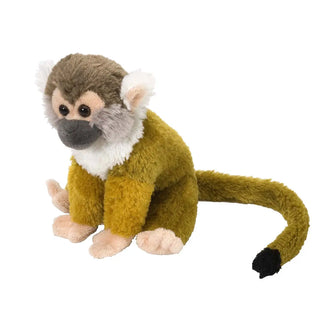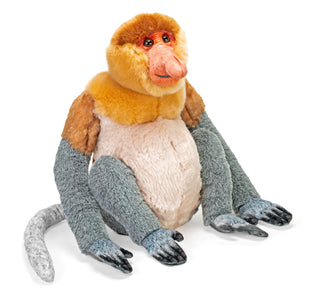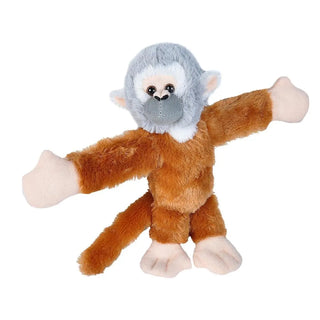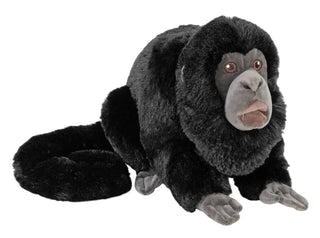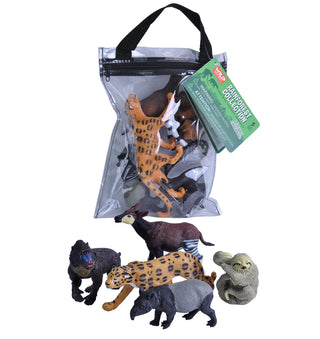Your Search For "monkey" Revealed The Following:
Filter
Active Filters
Squirrel Monkey Stuffed Animal - 8"
$12.99
- Unit price
- / per
INCLUDES:
- Age:0+
- AnimalType:Squirrel Monkey
- Brand:Cuddlekins
- Gender:Boy
- Gender:Girl
- Size:8"
- Squirrel Monkey
$12.99
- Unit price
- / per
Artist Collection Proboscis Monkey Stuffed Animal - 15"
$43.99
- Unit price
- / per
INCLUDES:
- Age:0+
- Brand:Artist Collection
- Gender:Boy
- Gender:Girl
- Size:15"
$43.99
- Unit price
- / per
Huggers Squirrel Monkey Stuffed Animal - 8"
$10.99
- Unit price
- / per
INCLUDES:
- Age:10M+
- AnimalType:Squirrel Monkey
- Brand:Huggers
- Easter
- Gender:Boy
- Gender:Girl
- Size:8"
- Squirrel Monkey
$10.99
- Unit price
- / per
Vibe Brights Blue Monkey Stuffed Animal - 20"
Regular price
$20.80
$25.99
Save 20%
- Unit price
- / per
INCLUDES:
- Age:0+
- Brand:Vibe Brights
- Features:With Light & Sound
- Gender:Boy
- Gender:Girl
- Size:20"
Regular price
$20.80
$25.99
Save 20%
- Unit price
- / per
Hanging Black Spider Monkey - 20"
$15.99
- Unit price
- / per
INCLUDES:
- Age:0+
- AnimalType:Monkey
- Brand:Hanging Monkeys
- Gender:Boy
- Gender:Girl
- Monkey
- Size:20"
$15.99
- Unit price
- / per
Artist Collection - Squirrel Monkey
Regular price
$32.80
$40.99
Save 20%
- Unit price
- / per
INCLUDES:
- Age:0+
- Brand:Artist Collection
- Gender:Boy
- Gender:Girl
- Size:15"
Regular price
$32.80
$40.99
Save 20%
- Unit price
- / per
Vibe Brights Rainbow Monkey Stuffed Animal - 20"
Regular price
$20.80
$25.99
Save 20%
- Unit price
- / per
INCLUDES:
- Age:0+
- Brand:Vibe Brights
- Features:With Light & Sound
- Gender:Boy
- Gender:Girl
- Size:20"
Regular price
$20.80
$25.99
Save 20%
- Unit price
- / per
Hanging Squirrel Monkey with Baby Stuffed Animal - 20"
$28.99
- Unit price
- / per
INCLUDES:
- Age:0+
- AnimalType:Squirrel Monkey
- Brand:Hanging Monkeys
- Gender:Boy
- Gender:Girl
- Size:20"
- Squirrel Monkey
$28.99
- Unit price
- / per
Sequin Purple Monkey
$19.99
- Unit price
- / per
INCLUDES:
- Age:0+
- AnimalType:Monkey
- Brand:Sequin Monkey
- Gender:Boy
- Gender:Girl
- Monkey
- Size:22"
$19.99
- Unit price
- / per
Vibe Brights Purple Monkey Stuffed Animal - 20"
Regular price
$20.80
$25.99
Save 20%
- Unit price
- / per
INCLUDES:
- Age:0+
- Brand:Vibe Brights
- Features:With Light & Sound
- Gender:Boy
- Gender:Girl
- Size:20"
Regular price
$20.80
$25.99
Save 20%
- Unit price
- / per
Huggers Red Monkey Stuffed Animal - 8"
$10.99
- Unit price
- / per
INCLUDES:
- Age:10M+
- AnimalType:Monkey
- Brand:Huggers
- Easter
- Gender:Boy
- Gender:Girl
- Monkey
- Size:8"
$10.99
- Unit price
- / per
Sequin Pink Monkey
$19.99
- Unit price
- / per
INCLUDES:
- Age:0+
- AnimalType:Monkey
- Brand:Sequin Monkey
- Gender:Boy
- Gender:Girl
- Monkey
- Size:22"
$19.99
- Unit price
- / per
Hanging White Handed Gibbon Stuffed Animal - 20"
$15.99
- Unit price
- / per
INCLUDES:
- Age:0+
- AnimalType:Lar Gibbon
- Brand:Hanging Monkeys
- Gender:Boy
- Gender:Girl
- Lar Gibbon
- Size:20"
$15.99
- Unit price
- / per
Rainforest Splendors Wolly Monkey Stuffed Animal - 6"
$14.99
- Unit price
- / per
INCLUDES:
- Age:0+
- Brand:Rainforest Splendors
- Gender:Boy
- Gender:Girl
- Size:6"
$14.99
- Unit price
- / per
Hanging Chimpanzee Stuffed Animal - 20"
$15.99
- Unit price
- / per
INCLUDES:
- Age:0+
- AnimalType:Chimpanzee
- Brand:Hanging Monkeys
- Chimpanzee
- Gender:Boy
- Gender:Girl
- Size:20"
$15.99
- Unit price
- / per
Squirrel Monkey Ecokins Hanging
$15.99
- Unit price
- / per
INCLUDES:
- Age:0+
- Brand:Ecokins Hanging
- Gender:Boy
- Gender:Girl
- Size:22"
$15.99
- Unit price
- / per
Ecokins Hanging Jumbo Squirrel Monkey Stuffed Animal - 48"
$39.99
- Unit price
- / per
INCLUDES:
- Age:0+
- Brand:Ecokins Hanging Monkey Jumbo
- Gender:Boy
- Gender:Girl
- Size:48"
$39.99
- Unit price
- / per
Rainforest Splendors Squirrel Monkey Stuffed Animal - 6"
$14.99
- Unit price
- / per
INCLUDES:
- Age:0+
- Brand:Rainforest Splendors
- Gender:Boy
- Gender:Girl
- Size:6"
$14.99
- Unit price
- / per
Hanging Pink Vibes Stuffed Animal - 20"
$25.99
- Unit price
- / per
INCLUDES:
- Age:0+
- AnimalType:Monkey
- Brand:Hanging Monkeys
- Gender:Boy
- Gender:Girl
- Monkey
- Size:20"
$25.99
- Unit price
- / per
Cuddlekins Eco Howler Monkey Stuffed Animal - 12"
$24.99
- Unit price
- / per
INCLUDES:
- Age:0+
- Brand:Cuddlekins Eco
- Gender:Boy
- Gender:Girl
- Size:12"
$24.99
- Unit price
- / per
Hanging Common Langur with Baby Stuffed Animal - 20"
$28.99
- Unit price
- / per
INCLUDES:
- Age:0+
- AnimalType:Common Langur
- Brand:Hanging Monkeys
- Common Langur
- Gender:Boy
- Gender:Girl
- Size:20"
$28.99
- Unit price
- / per
Rainforest Splendors Wolf’s Mona Monkey Stuffed Animal - 6"
$14.99
- Unit price
- / per
INCLUDES:
- Age:0+
- Brand:Rainforest Splendors
- CMTBT
- Gender:Boy
- Gender:Girl
- Size:6"
$14.99
- Unit price
- / per
Hanging Vervet - 20"
$15.99
- Unit price
- / per
INCLUDES:
- Age:0+
- AnimalType:Monkey
- Brand:Hanging Monkeys
- Gender:Boy
- Gender:Girl
- Monkey
- Size:20"
$15.99
- Unit price
- / per
Hanging Orangutan Stuffed Animal - 20"
$15.99
- Unit price
- / per
INCLUDES:
- Age:0+
- AnimalType:Orangutan
- Brand:Hanging Monkeys
- Gender:Boy
- Gender:Girl
- Orangutan
- Size:20"
$15.99
- Unit price
- / per
Capuchin Stuffed Animal - 8"
$12.99
- Unit price
- / per
INCLUDES:
- Age:0+
- AnimalType:Capuchin
- Brand:Cuddlekins
- Capuchin
- Gender:Boy
- Gender:Girl
- Size:8"
$12.99
- Unit price
- / per
Hanging Cotton-Top Tamarin Stuffed Animal - 20"
$15.99
- Unit price
- / per
INCLUDES:
- Age:0+
- AnimalType:Cotton-Top Tamarin
- Brand:Hanging Monkeys
- Cotton-Top Tamarin
- Gender:Boy
- Gender:Girl
- Size:20"
$15.99
- Unit price
- / per
Hanging Marmoset - 20"
$15.99
- Unit price
- / per
INCLUDES:
- Age:0+
- AnimalType:Monkey
- Brand:Hanging Monkeys
- Gender:Boy
- Gender:Girl
- Monkey
- Size:20"
$15.99
- Unit price
- / per
Huggers Gorilla Stuffed Animal - 8"
$10.99
- Unit price
- / per
INCLUDES:
- Age:10M+
- Brand:Huggers
- Gender:Boy
- Gender:Girl
- Size:8"
$10.99
- Unit price
- / per
Rainforest Splendors White Faced Capuchin Stuffed Animal - 6"
$14.99
- Unit price
- / per
INCLUDES:
- Age:0+
- Brand:Rainforest Splendors
- Gender:Boy
- Gender:Girl
- Size:6"
$14.99
- Unit price
- / per
Chimpanzee Stuffed Animal - 12"
$22.99
- Unit price
- / per
INCLUDES:
- Age:0+
- AnimalType:Chimpanzee
- Brand:Cuddlekins
- Chimpanzee
- Gender:Boy
- Gender:Girl
- Size:12"
$22.99
- Unit price
- / per
Pink Sloth Stuffed Animal
$22.99
- Unit price
- / per
INCLUDES:
- Age:0+
- AnimalType:Sloth
- Brand:Cuddlekin Vibes
- Gender:Boy
- Gender:Girl
- Size:12"
- Sloth
$22.99
- Unit price
- / per
Baby Chimpanzee Stuffed Animal - 8"
$12.99
- Unit price
- / per
INCLUDES:
- Age:0+
- AnimalType:Chimpanzee
- Brand:Cuddlekins
- Chimpanzee
- Gender:Boy
- Gender:Girl
- Size:8"
$12.99
- Unit price
- / per
Chimpanzee Stuffed Animal - 12"
$19.99
- Unit price
- / per
INCLUDES:
- Age:0+
- Brand:Ecokins
- Gender:Boy
- Gender:Girl
- Size:12"
$19.99
- Unit price
- / per
The Canopy Explorer Bundle
Regular price
$57.99
$67.95
Save 15%
- Unit price
- / per
INCLUDES:
- Cuddlekins Mini Squirrel Monkey 8"
- Cuddlekins Sloth 12"
- Flipkins Capybara 5"
- Hug'Ems Mini Sloth 7"
- Huggers Squirrel Monkey 8"
Regular price
$57.99
$67.95
Save 15%
- Unit price
- / per
Hanging Squirrel Monkey Stuffed Animal - 20"
$15.99
- Unit price
- / per
INCLUDES:
- Age:0+
- AnimalType:Squirrel Monkey
- Brand:Hanging Monkeys
- Gender:Boy
- Gender:Girl
- Size:20"
- Squirrel Monkey
$15.99
- Unit price
- / per
Hanging Capuchin - 20"
$15.99
- Unit price
- / per
INCLUDES:
- Age:0+
- AnimalType:Monkey
- Brand:Hanging Monkeys
- Gender:Boy
- Gender:Girl
- Monkey
- Size:20"
$15.99
- Unit price
- / per
Hanging Colobus Monkey Stuffed Animal - 20"
$15.99
- Unit price
- / per
INCLUDES:
- Age:0+
- AnimalType:Colobus Monkey
- Brand:Hanging Monkeys
- Colobus Monkey
- Gender:Boy
- Gender:Girl
- Size:20"
$15.99
- Unit price
- / per
Hanging Lar Gibbon Stuffed Animal - 20"
$15.99
- Unit price
- / per
INCLUDES:
- Age:0+
- AnimalType:Lar Gibbon
- Brand:Hanging Monkeys
- Gender:Boy
- Gender:Girl
- Lar Gibbon
- Size:20"
$15.99
- Unit price
- / per
Light-Up Purple Hanging Monkey
$19.99
- Unit price
- / per
INCLUDES:
- Age:3+
- Brand:Vibe Brights
- Features:With Light & Sound
- Gender:Boy
- Gender:Girl
- Size:22"
$19.99
- Unit price
- / per
Hanging Blue Vibes Stuffed Animal - 20"
$25.99
- Unit price
- / per
INCLUDES:
- Age:0+
- AnimalType:Monkey
- Brand:Hanging Monkeys
- Gender:Boy
- Gender:Girl
- Monkey
- Size:20"
$25.99
- Unit price
- / per
Hanging Sloth Stuffed Animal - 20"
$30.99
- Unit price
- / per
INCLUDES:
- Age:0+
- AnimalType:Sloth
- Brand:Hanging Monkey
- Gender:Boy
- Gender:Girl
- Size:20"
- Sloth
$30.99
- Unit price
- / per
Hanging Chimpanzee with Baby Stuffed Animal - 20"
$28.99
- Unit price
- / per
INCLUDES:
- Age:0+
- AnimalType:Chimpanzee
- Brand:Hanging Monkeys
- Chimpanzee
- Gender:Boy
- Gender:Girl
- Size:20"
$28.99
- Unit price
- / per
Ecokins Hanging Wolf’s Mona Monkey Stuffed Animal - 22"
$15.99
- Unit price
- / per
INCLUDES:
- Age:0+
- Brand:Ecokins Hanging
- Gender:Boy
- Gender:Girl
- Size:22"
$15.99
- Unit price
- / per
Hanging Green Vibes Stuffed Animal - 20"
$25.99
- Unit price
- / per
INCLUDES:
- Age:0+
- AnimalType:Monkey
- Brand:Hanging Monkeys
- Gender:Boy
- Gender:Girl
- Monkey
- Size:20"
$25.99
- Unit price
- / per
Hanging Blue Sequin Stuffed Animal - 20"
$19.99
- Unit price
- / per
INCLUDES:
- Age:0+
- AnimalType:Monkey
- Brand:Hanging Monkeys
- Gender:Boy
- Gender:Girl
- Monkey
- Size:20"
$19.99
- Unit price
- / per
Hanging Ring Tailed Lemur Stuffed Animal - 20"
$15.99
- Unit price
- / per
INCLUDES:
- Age:0+
- AnimalType:Ring Tailed Lemur
- Brand:Hanging Monkeys
- Gender:Boy
- Gender:Girl
- Ring Tailed Lemur
- Size:20"
$15.99
- Unit price
- / per
Zip Polybag of Rainforest Figurines
$21.99
- Unit price
- / per
INCLUDES:
- Age:3+
- AnimalType:Penguin
- Brand:Wild Republic Polybags
- Features:Zipped
- Gender:Boy
- Gender:Girl
- Penguin
$21.99
- Unit price
- / per
Huggers Chimp Stuffed Animal - 8"
$10.99
- Unit price
- / per
INCLUDES:
- Age:10M+
- AnimalType:Chimpanzee
- Brand:Huggers
- Chimpanzee
- Easter
- Gender:Boy
- Gender:Girl
- Size:8"
$10.99
- Unit price
- / per
- 1
- 2
-
You're viewing 1-48 of 50 results

